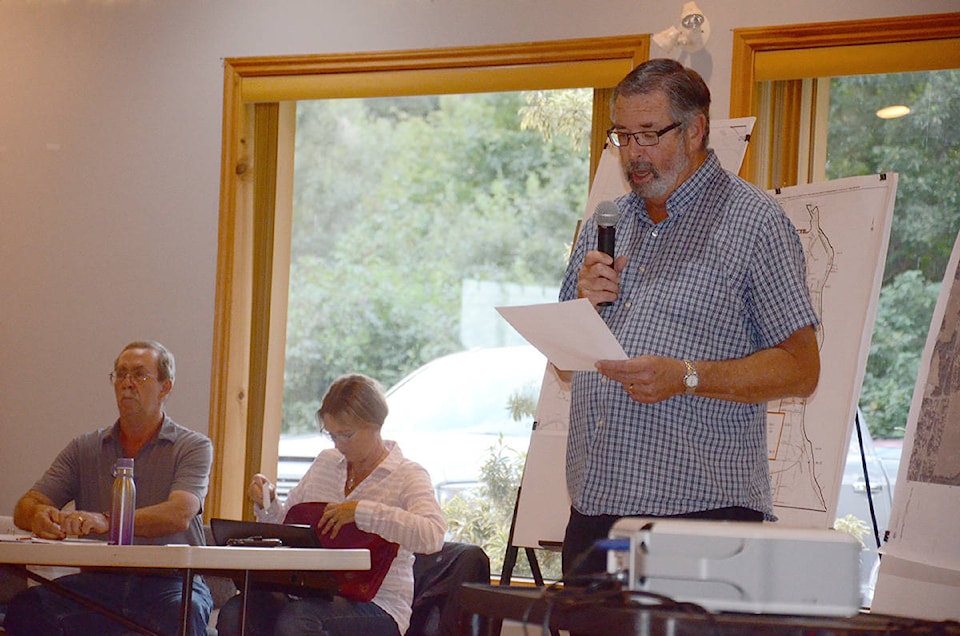Even with the recent water rate hikes northern Area D residents are facing from the City of Campbell River, hooking up to the city’s system is still cheaper than the system to the south, says Bob Solc.
However, the price is going up and not expected to fall in the coming years.
In June, the Strathcona Regional District brought in hefty increases for residents in northern Area D because of higher costs from Campbell River.
RELATED STORY: Strathcona Regional District hikes water rates for rural area
On Wednesday night, Solc, a retired engineer, and his wife Deborah Solc, a retired geologist, spoke to a group of more than 75 fellow residents inside the meeting room at the Oyster Bay Resort. On behalf of the Area D Residents and Ratepayers Association (ADRRA) the Solcs were presenting preliminary research on a water source for the electoral area that could provide an alternative to buying bulk water from Campbell River.
“All of this work didn’t cost anybody in Area D one thin dime,” ADRRA president Rod Nugent told the crowd.
Bob Solc said that while being hooked up to the city’s water had traditionally been cheaper, the costs would continue to rise, especially in light of excessive water use. He said the best estimates indicate that, by comparison, residents in the north use two to two-and-a-half times more water than people to the south.
The problem, Solc continued, was that almost no one in the north is on meters, a situation that not only discourages water conservation but also means a lack of data to determine whether leaks in the decades-old system are a problem and, if so, where these leaks are occurring.
In the eyes of some, leaks are a major contributor to the problem. Prior to the meeting a resident was distributing data compiled at the SRD office about monthly water use rates in the area from 2013 to 2017. Diana Shellard notes in the handout she found excessive water use in August 2016 of 134,864 cubic metres, compared with 84,666 the previous August.
“It was impossible not to notice the spike,” she writes. “Taking a look at the monthly rainfall against the consumption data… the irregularity starts here.”
Environment Canada data show the month’s 75.4 millimetres was wetter than average of 59 millimetres, though most was concentrated at the beginning of the month and the last few days following a dry spell of more than two weeks. In fact, more than a third of the month’s total came on Aug. 30. The total was also less that August than the year before, though not significantly.
Some months the last two years do show increases from year to year, notably the winter months of early 2017, though other months such as November and December 2017 show declines. One man at the meeting, who said he had worked in the water business for years, reiterated leaks are a major contributor to heavy use.
Solc agreed, referring to SRD reports that indicate 15 per cent of use could be due to leaks, though he added at present people can only speculate.
“Without meters, we have no idea where that water is going,” he said.
In response, the SRD is in the process of applying for a grant that would cover much of the cost to install water meters at homes in northern Area D. If the SRD can get residents on meters, Solc suggested, it could help encourage conservation and provide information about the extent of leaks in the system and where they could be occurring.
RELATED STORY: Strathcona Regional District wants water meters for northern Area D
As far as the potential source of water – the reason for the presentation – the Solcs discussed the site they studied with the landowner’s blessing, which lies north of Oyster River and east of Hwy. 19A.
Their maps show two to three potential sites for large wells that could potentially meet the water needs for all residents in Area D, including those in Oyster Bay who are on a system with Black Creek within the Comox Valley Regional District.
Deborah Solc said their work showed the potential sites are connected and are being replenished each year by the Oyster River system, though she stressed the need for more research.
“This water study is a preliminary review,” she said. “It definitely should be followed up by more detailed analysis.”
RELATED STORY: Residents identified new water source for rural area south of Campbell River
Bob Solc said several parties, including the Comox Valley and Strathcona regional districts, need to work together on this issue, adding he wished the Area D Director had been in attendance at Wednesday’s meeting. The hope now is for the SRD to look for funding of approximately $112,000 to cover further study of the site this fall to confirm the site’s ability to provide water.
If this investigation supports the Solcs’ findings, the regional district could pursue further grants to develop the site and hook into the current distribution system in northern Area D, or even provide an alternate plan in negotiations with Campbell River over the price of water.
“Right now, Area D is handcuffed,” Solc said.
